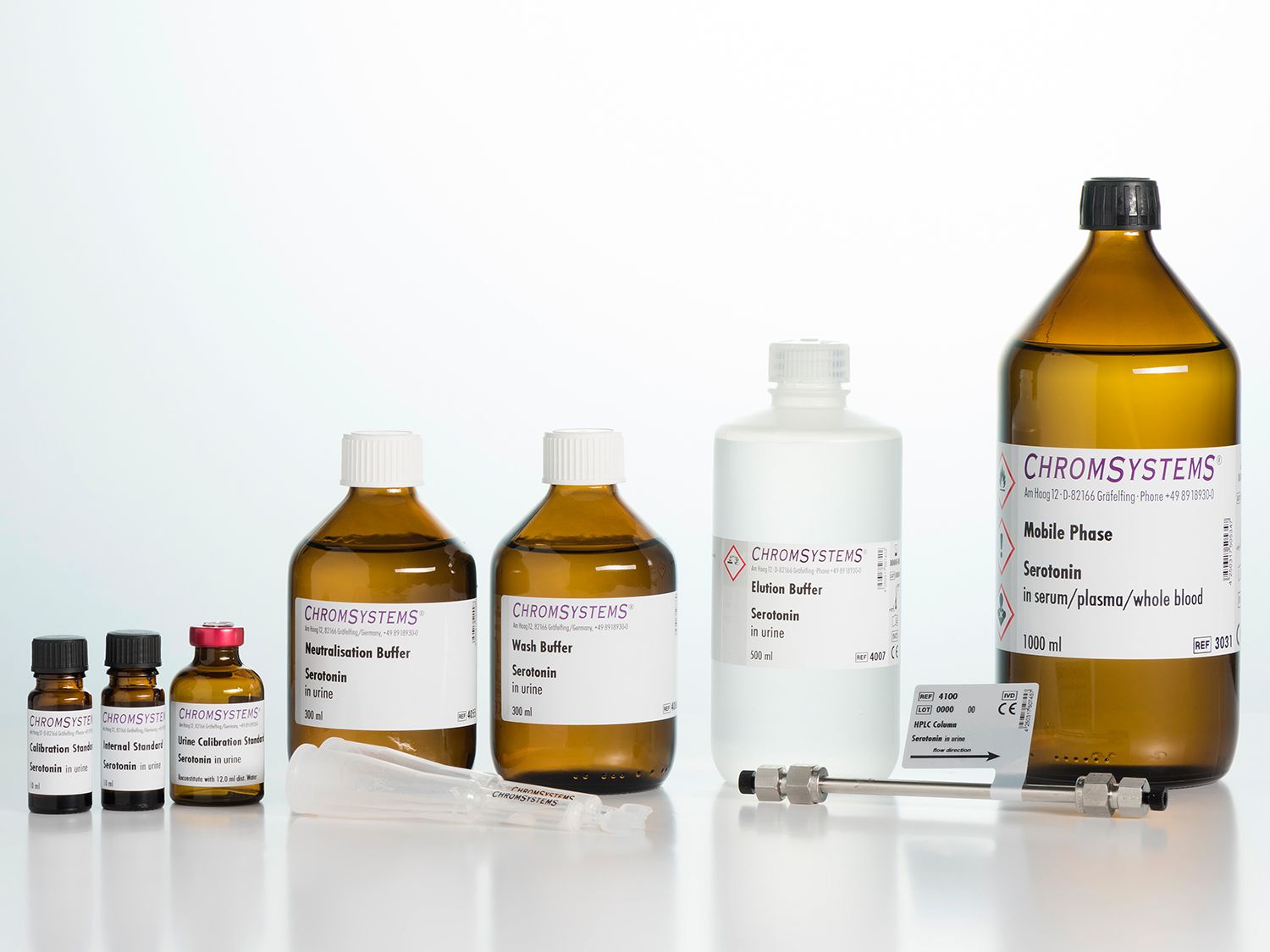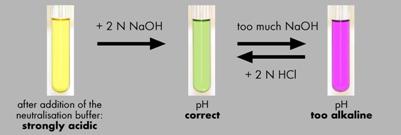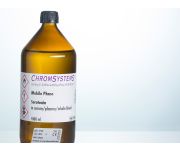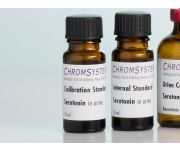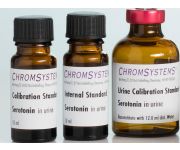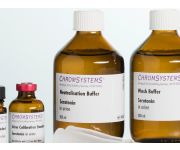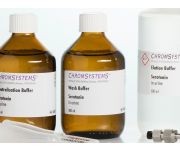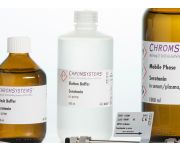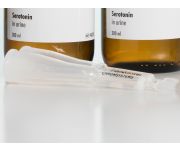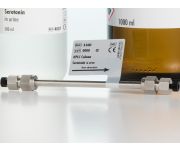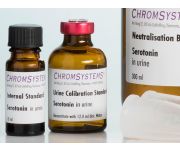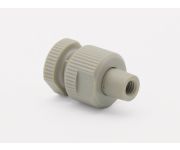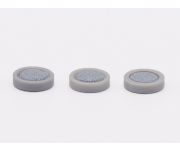Serotonin in Urine - HPLC
Easy sample preparation
Simple pH adjustment with pH indicator
Short run time
CE-IVD validated product ready for IVDR within timeframes and transition periods specified by the IVDR 2017/746
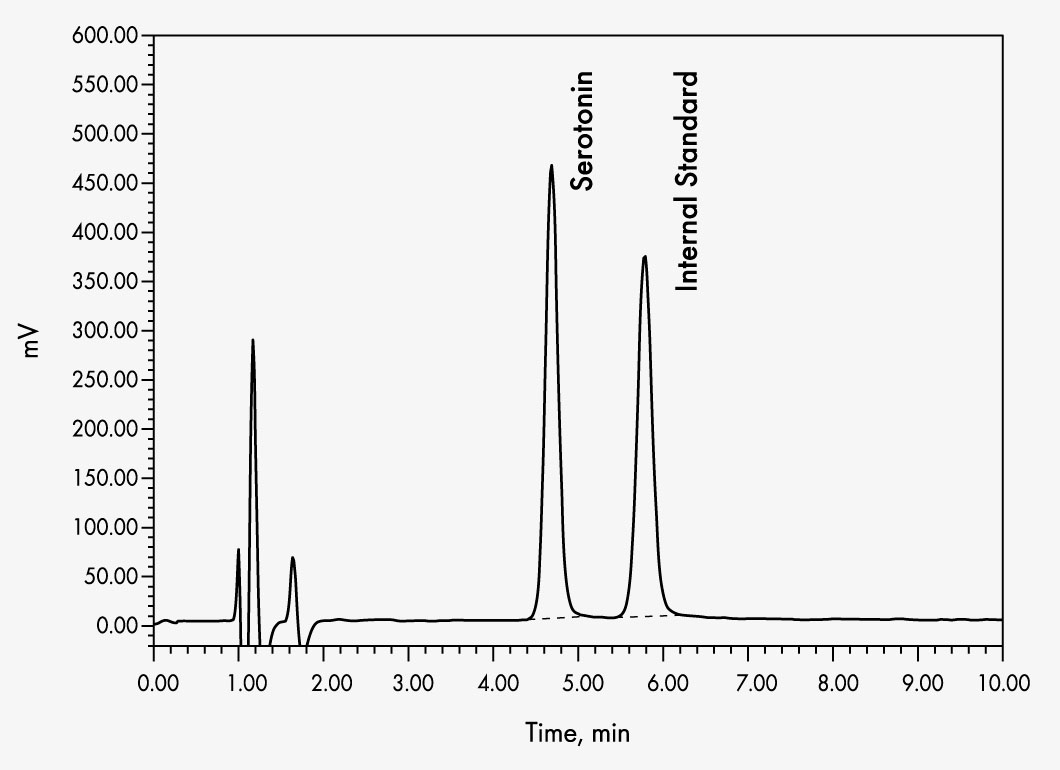

Serotonin
Clinical relevance
Serotonin (5-hydroxytryptamine) is a biogenic amine. In humans, serotonin is involved in a large number of physiological processes, e.g. it acts as a tissue hormone and neurotransmitter in the central nervous system, the enteric nervous system and the cardiovascular system. A large amount of serotonin is found in the chromaffin cells of the gastrointestinal tract where it is part of the gastrointestinal hormone system. When released into the capillary blood, serotonin is almost absorbed by the thrombocytes.
A number of diseases are associated with pathological changes in the serotonin metabolism. For the routine, the diagnosis of carcinoid tumours together with the analysis of 5-hydroxyindoleacetic acid (5-HIAA) is very important.
This assay allows determination of serotonin in urine with HPLC (high performance liquid chromatography) with electrochemical detection.
It is intended as a monitoring test for patients with suspected serotonin-secreting tumours.
Product advantages
• Easy sample preparation
• Simple pH adjustment with pH indicator
• Short run time
Assay characteristics
The chromatographic determination requires an isocratic HPLC system with electrochemical detection. Calibrator and quality controls are available separately – they are produced from human matrices to prevent matrix-associated measurement variabilities.
Alternatively, Chromsystems offers an assay for determining serotonin in serum/plasma and whole blood (order no. 3030).
Detailed performance evaluation data for this assay can be found in the appendices of the instruction manual.
| Method of Analysis | HPLC |
|---|---|
| Number of Tests | 100 |
| Please note | The information listed here, including the sample preparation, is not sufficient for using the product. Please read the information provided in the instruction manual, which includes detailed information on limitations associated with the use of the product in line with its intended purpose. Detailed performance evaluation data for this assay can be found in the appendices of the instruction manual. |
| Lower Limit of Quantitation | 5 µg/l |
| Upper Limit of Quantification | up to 1000 µg/l |
| Lower and Upper Limit of Quantitation | 5 µg/l – 1000 µg/l |
| Intraassay | CV < 2 % |
| Interassay | CV < 3 % |
| Recovery | ~ 99 % |
| Specimen | 24 h urine (containing 10 ml 25 % HCl) or spontaneous urine (refer data to urine creatinine). |
| Sample Preparation | The information on the sample preparation presented here is not sufficient for use in the laboratory. For a detailed step by step description, please refer to the instruction manual.
|
| Run Time | aproxx. 8 min |
| Injection Volume | 20-50 µl |
| Flow Rate | 0.8-1.3 ml/min |
| Column Temperature | ambient (~25 °C) |
| Potential | approx. +400 to +500 mV |
| Additional Info | For the HPLC analysis of serotonin in urine any isocratic HPLC system with electrochemical detector is suitable. |
| Parameters | Serotonin |


Serotonin
Clinical relevance
Serotonin (5-hydroxytryptamine) is a biogenic amine. In humans, serotonin is involved in a large number of physiological processes, e.g. it acts as a tissue hormone and neurotransmitter in the central nervous system, the enteric nervous system and the cardiovascular system. A large amount of serotonin is found in the chromaffin cells of the gastrointestinal tract where it is part of the gastrointestinal hormone system. When released into the capillary blood, serotonin is almost absorbed by the thrombocytes.
A number of diseases are associated with pathological changes in the serotonin metabolism. For the routine, the diagnosis of carcinoid tumours together with the analysis of 5-hydroxyindoleacetic acid (5-HIAA) is very important.
This assay allows determination of serotonin in urine with HPLC (high performance liquid chromatography) with electrochemical detection.
It is intended as a monitoring test for patients with suspected serotonin-secreting tumours.
Product advantages
• Easy sample preparation
• Simple pH adjustment with pH indicator
• Short run time
Assay characteristics
The chromatographic determination requires an isocratic HPLC system with electrochemical detection. Calibrator and quality controls are available separately – they are produced from human matrices to prevent matrix-associated measurement variabilities.
Alternatively, Chromsystems offers an assay for determining serotonin in serum/plasma and whole blood (order no. 3030).
Detailed performance evaluation data for this assay can be found in the appendices of the instruction manual.
| Method of Analysis | HPLC |
|---|---|
| Number of Tests | 100 |
| Please note | The information listed here, including the sample preparation, is not sufficient for using the product. Please read the information provided in the instruction manual, which includes detailed information on limitations associated with the use of the product in line with its intended purpose. Detailed performance evaluation data for this assay can be found in the appendices of the instruction manual. |
| Lower Limit of Quantitation | 5 µg/l |
| Upper Limit of Quantification | up to 1000 µg/l |
| Lower and Upper Limit of Quantitation | 5 µg/l – 1000 µg/l |
| Intraassay | CV < 2 % |
| Interassay | CV < 3 % |
| Recovery | ~ 99 % |
| Specimen | 24 h urine (containing 10 ml 25 % HCl) or spontaneous urine (refer data to urine creatinine). |
| Sample Preparation | The information on the sample preparation presented here is not sufficient for use in the laboratory. For a detailed step by step description, please refer to the instruction manual.
|
| Run Time | aproxx. 8 min |
| Injection Volume | 20-50 µl |
| Flow Rate | 0.8-1.3 ml/min |
| Column Temperature | ambient (~25 °C) |
| Potential | approx. +400 to +500 mV |
| Additional Info | For the HPLC analysis of serotonin in urine any isocratic HPLC system with electrochemical detector is suitable. |
| Parameters | Serotonin |

